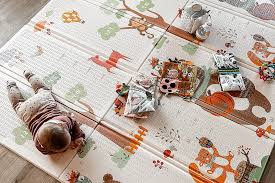
Babies are naturally curious explorers, eager to interact with the speelkleden world around them. As they grow, their senses develop rapidly, and the environment plays a crucial role in shaping their cognitive and motor skills. One of the simplest yet most effective tools for aiding this development is the baby playmat. These colorful, padded surfaces are more than just a comfortable place for babies to lie down—they’re a gateway to sensory exploration, motor skill enhancement, and imaginative play.
The Importance of Play for Babies
In the early months and years of life, play is the primary way babies learn about their environment. Playmats provide a safe, stimulating space where infants can engage with their surroundings, encouraging movement, touch, and sensory interaction. For babies, this time spent on a playmat is vital for:
- Motor Skill Development: Rolling, reaching, and pushing up onto their arms during tummy time are all actions encouraged by playmats. These motions help build strength in babies’ muscles, setting the stage for crawling and, eventually, walking.
- Cognitive Growth: Many playmats include vibrant colors, textures, and toys that engage babies’ senses, fostering brain development. When babies reach for objects, they are practicing hand-eye coordination and problem-solving skills.
- Sensory Stimulation: The diverse patterns, shapes, and sounds provided by playmats can stimulate a baby’s visual, auditory, and tactile senses. This multi-sensory experience is crucial for helping babies understand how their bodies relate to the world around them.
Types of Baby Playmats
There are many different types of playmats, each designed to support various aspects of a baby’s growth. Let’s explore a few popular categories:
- Foam Playmats: Made from soft, cushioned materials, foam playmats offer a safe and comfortable space for babies to move around. These mats often feature bold colors or alphabet and number prints, helping babies learn to recognize shapes and patterns.
- Activity Gyms: These playmats come with built-in arches from which toys, rattles, or mirrors hang, encouraging babies to reach, grasp, and bat at objects. The design of activity gyms helps stimulate motor skills and visual tracking.
- Puzzle Playmats: These mats come in interlocking pieces that can be assembled like a puzzle. They’re great for older babies and toddlers, encouraging both motor development and cognitive problem-solving as they figure out how to fit the pieces together.
- Fabric Playmats: These lightweight, often foldable mats are typically made of fabric and may include features like crinkly surfaces or attached toys for sensory play. They are ideal for parents who want something portable and easy to pack for outings.
Tummy Time: The Unsung Hero of Baby Development
One key activity associated with playmats is tummy time. This simple practice involves placing a baby on their stomach while they are awake and supervised. Tummy time is essential for strengthening a baby’s neck, shoulders, and arms, which are critical for motor milestones like crawling. Playmats offer a soft, engaging surface that makes tummy time enjoyable and less strenuous.
Playmats with built-in toys or mirrors can help make tummy time more interesting. Babies are naturally drawn to their reflections and love reaching for colorful objects. These distractions help keep babies entertained while they develop upper body strength and motor skills.
How to Choose the Right Playmat
When selecting a playmat, there are several factors to consider to ensure it’s the right fit for your baby:
- Safety: Look for playmats made from non-toxic materials that are free from harmful chemicals like BPA or phthalates. Ensure the mat is large enough to provide a spacious, hazard-free play area.
- Cushioning: The mat should be thick enough to provide cushioning against falls, especially as babies start sitting up or practicing tummy time.
- Interactivity: Consider playmats that offer added stimulation, such as hanging toys, mirrors, or tactile elements. These features can keep your baby engaged longer and offer more developmental benefits.
- Portability: If you’re often on the go, opt for a lightweight or foldable playmat that’s easy to transport.
- Ease of Cleaning: Babies are known for making messes! A waterproof, wipe-clean surface or machine-washable material can be a lifesaver when dealing with spit-up, drool, or other messes.
The Lasting Benefits of Playmats
The benefits of baby playmats extend far beyond infancy. As your baby grows into a toddler, the playmat can become a space for imaginative play, story time, and even learning basic concepts like colors, letters, and numbers. A versatile playmat can evolve with your child, providing a familiar, comforting space for various stages of development.
In addition to fostering physical and cognitive growth, playmats can also offer babies a sense of independence. As they lie on their mats, reaching for toys or rolling over, they begin to understand their ability to interact with the world on their own terms—a fundamental step in the journey toward independence.
Conclusion
Playmats are a simple yet powerful tool for early childhood development. They provide a safe, stimulating environment where babies can practice essential motor and cognitive skills. Whether you’re looking for a basic foam mat, an activity gym, or a puzzle playmat, there’s an option to suit every baby’s needs. Investing in a high-quality playmat not only ensures your baby has a comfortable space for play but also gives them a head start in learning and development.
